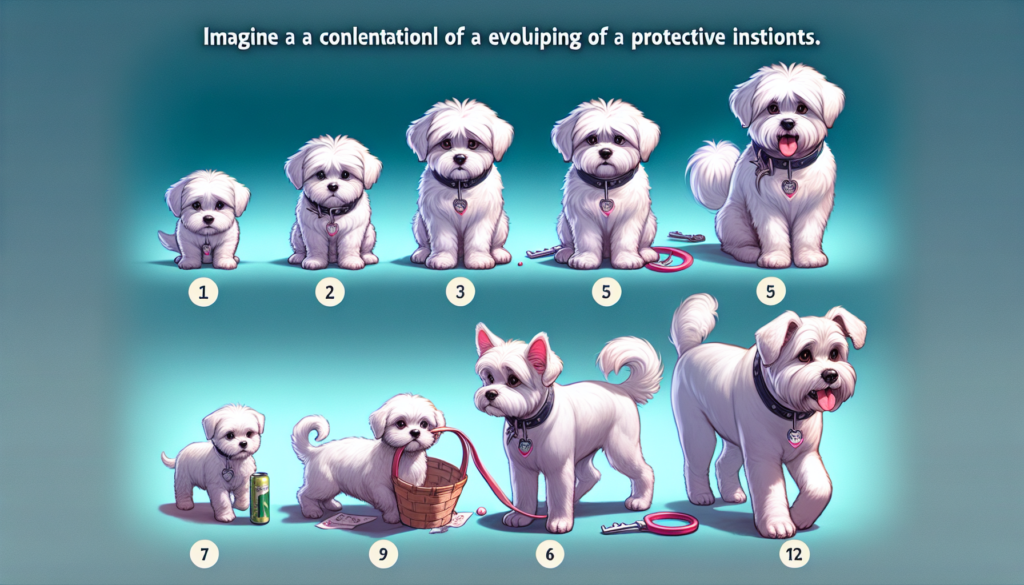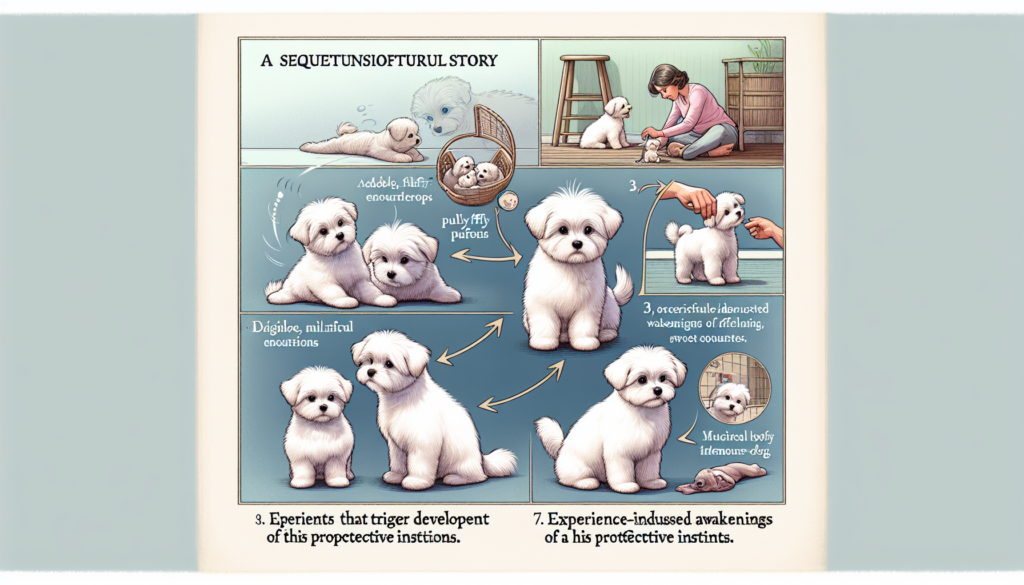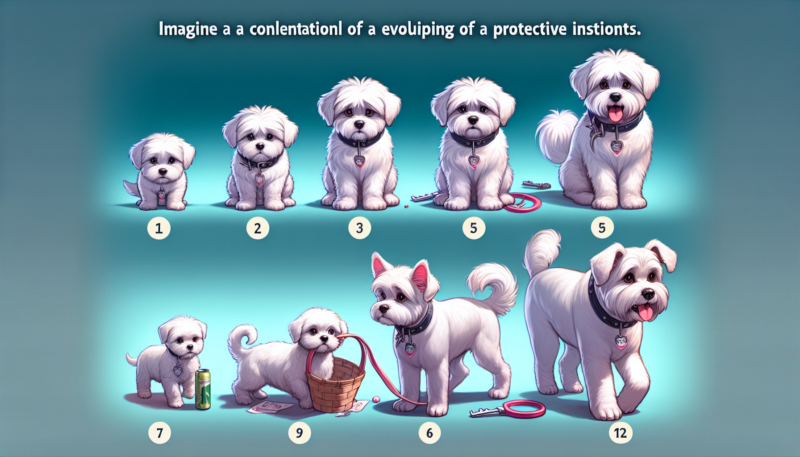Maltese dogs are known for their petite size and adorable appearance, but beneath their fluffy exterior lies a surprising trait – protectiveness. These little pooches may seem like cuddly companions, but as they grow older, they can develop a strong sense of loyalty towards their owners. Understanding when this protectiveness emerges is crucial for owners, as it allows them to nurture and encourage this behavior. In this article, we will explore the different stages of a Maltese dog’s life and discover when they typically become protective, providing valuable insights for those looking to encourage this instinct in their furry friends.
Development stages of Maltese dogs
Puppyhood
During puppyhood, Maltese dogs are playful and curious. They are still learning about their surroundings and are not yet fully aware of their protective instincts. However, this stage of development is crucial for setting the foundation of their behavior. It is important to provide them with positive socialization experiences, as this will shape their protective behavior later on.
Adolescence
As Maltese dogs enter adolescence, they start to exhibit more independence and may become more alert to their surroundings. They may start to display protective behavior towards their family members or possessions. This is a natural part of their development as they begin to mature and establish their roles within the household.
Adulthood
Once Maltese dogs reach adulthood, their protective instincts become more prominent. They are fully aware of their surroundings and are generally more vigilant. They may exhibit protective behavior towards their family members, property, or territory. This is the stage where their protective instincts are fully realized, and their behavior may be influenced by a combination of genetics, socialization, training, environment, and health factors.
Factors Influencing Protective Behavior in Maltese Dogs
Genetics
Genetics play a significant role in determining a Maltese dog’s protective behavior. Certain traits may be inherited from their parents, such as a predisposition towards being protective. While each dog is unique, understanding the breed’s tendencies can give you a general idea of what to expect. Maltese dogs are known to be affectionate and loyal, and these traits can contribute to their protective instincts.
Socialization
Socialization is a crucial factor in shaping a Maltese dog’s protective behavior. Exposing them to various people, animals, and environments from a young age helps them develop confidence and teaches them appropriate responses in different situations. Proper socialization helps prevent fear or aggression-based protective behavior and promotes a balanced and well-rounded temperament.
Training
Training is essential in molding a Maltese dog’s protective behavior. Basic obedience training establishes a foundation of good behavior, which can help in managing their protective instincts. Teaching them commands like “sit,” “stay,” and “leave it” enables you to have better control over their responses in different situations. Additionally, specialized guarding training can be implemented to hone their protective instincts in a controlled manner.
Environment
The environment in which a Maltese dog lives can influence their protective behavior. A stable and secure home environment helps foster a sense of territory, which can contribute positively to their protective instincts. If they feel safe and protected within their surroundings, they are more likely to exhibit appropriate protective behavior. On the other hand, an unstable or unpredictable environment can increase anxiety and fear, potentially resulting in overprotective or reactive behavior.
Health
The physical and emotional well-being of a Maltese dog can also impact their protective instincts. A dog in optimal physical health is more likely to exhibit balanced behavior, while any pain or discomfort could lead to increased vigilance or aggression. Additionally, addressing their emotional well-being through regular exercise, mental stimulation, and positive reinforcement can help them feel more secure and confident, reducing the likelihood of fear-based protective behavior.

The Role of Genetics in Protective Behavior
Inherited traits
Genetics play a role in determining a Maltese dog’s protective behavior. Certain traits related to protectiveness can be passed down from their parents, but it’s important to remember that every dog is an individual. While some Maltese dogs may naturally exhibit stronger protective instincts, others may be more laid-back and less inclined to guard. Understanding and acknowledging these innate traits can help in managing their behavior effectively.
Breed-specific tendencies
As a breed, Maltese dogs are known for their affectionate and loyal nature. These traits often contribute to their protective instincts towards their family members. While they may not possess the same level of guarding abilities as larger breeds, they make up for it with their unwavering loyalty. It is essential to consider the breed-specific tendencies when assessing a Maltese dog’s protective behavior and tailoring training and socialization accordingly.
Socialization and its Impact on Protective Behavior
The critical period
The critical period for socialization in Maltese dogs occurs between the ages of 4 and 14 weeks. During this time, their brains are highly receptive to learning and experiences. Introducing them to a wide range of people, animals, and environments helps them become comfortable and confident in various situations. A lack of proper socialization during this critical period may result in fear-based protective behavior later on.
Exposure to different situations
Introducing a Maltese dog to different situations and environments plays a vital role in shaping their protective behavior. Regular exposure to new sights, sounds, smells, and experiences helps them become accustomed to unfamiliar stimuli. It teaches them that not every new situation is a threat and helps prevent overprotectiveness or reactivity in the face of the unknown.
Positive reinforcement
Using positive reinforcement techniques during socialization helps reinforce desired behavior and builds a strong bond between the dog and its owner. Rewarding them with treats, praise, or play for calm and appropriate responses to new experiences encourages them to associate positive outcomes with unfamiliar situations. This positive association helps them approach new encounters with confidence and reduces the likelihood of fear-based protective behavior.

Training for Protective Behavior
Basic obedience training
Basic obedience training is an important foundation for managing a Maltese dog’s protective behavior. Teaching them essential commands like “sit,” “stay,” “leave it,” and “come” helps establish control and allows you to redirect their protective impulses when necessary. Training sessions should be positive, consistent, and reward-based to encourage desired behavior and reinforce their role as a well-behaved family member.
Guarding training
If you wish to enhance your Maltese dog’s protective instincts in a controlled and safe manner, specialized guarding training can be an option. This type of training focuses on teaching your dog when it is appropriate to protect and when to stand down. It involves teaching them specific commands, such as “guard” and “release,” and exposing them to various scenarios that mimic potential threats. Professional guidance is highly recommended when undertaking guarding training to ensure the safety and well-being of both the dog and the individuals involved.
Controlling protective instincts
While it is important to nurture a Maltese dog’s protective instincts, it is equally important to teach them when their protective behavior is not necessary or appropriate. This can be achieved through consistent reinforcement of obedience commands and setting clear boundaries. Teaching them a “quiet” or “enough” command can help control excessive barking or reactivity. Additionally, redirecting their attention to positive activities or providing them with interactive toys can help alleviate their protective instincts in non-threatening situations.
Influence of Environment on Protective Behavior
Home environment
The home environment plays a significant role in shaping a Maltese dog’s protective behavior. Providing a stable, secure, and loving home creates a sense of safety and comfort for them. Maltese dogs are naturally territorial, and establishing a consistent routine with defined boundaries helps them feel secure in their role as protectors of their family and territory.
Encouraging a sense of territory
Encouraging a sense of territory can help enhance a Maltese dog’s protective instincts in a healthy way. Designating specific areas where they feel responsible and establishing rules around entrances and exits can help them feel more in control of their environment. However, it is important to ensure that their territorial behavior does not become excessive or aggressive, as it can lead to behavior problems.
Fear-based protective behavior
An unpredictable or fear-inducing environment can significantly influence a Maltese dog’s protective behavior. Dogs who have experienced traumatic events or have had negative encounters with people or other animals may exhibit fear-based protective behavior. It is crucial to create a calm and supportive environment, addressing any fears or anxieties they may have through positive reinforcement and desensitization techniques. Consulting with a professional trainer or behaviorist can be helpful in managing and addressing fear-based protective behavior.
Effects of Health on Protective Instincts
Physical health
A Maltese dog’s physical health can impact their protective instincts. Any underlying health issues or discomfort they may be experiencing can increase their alertness or reactivity. Regular veterinary check-ups and addressing any health concerns promptly are essential to ensure their well-being and overall balanced behavior.
Pain or discomfort
Similar to physical health, any pain or discomfort a Maltese dog may be experiencing can affect their protective instincts. Whether it’s a temporary injury or a chronic condition, dogs may display heightened vigilance or aggression as a protective response to alleviate their pain. Providing appropriate medical care and pain management is crucial to address their discomfort and manage their behavior effectively.
Emotional well-being
Emotional well-being is closely tied to a Maltese dog’s protective instincts. Dogs who feel loved, secure, and emotionally balanced are less likely to exhibit overprotective or reactive behavior. Engaging them in activities they enjoy, providing mental stimulation, and spending quality time together helps them develop a stronger bond and a greater sense of safety. Regular positive reinforcement further reinforces their role as valued members of the family and cultivates a balanced and stable temperament.
Early Signs of Protective Behavior in Maltese Dogs
Barking at strangers
One of the early signs of protective behavior in Maltese dogs is barking at strangers or unfamiliar individuals. This behavior is generally exhibited as a warning signal to protect their owners and their home. While some level of alertness is normal, excessive or persistent barking can be a sign of anxiety or fear-based protective behavior.
Guarding possessions
Maltese dogs may also display possessive behavior towards their toys, food, or other possessions. This can manifest as growling, snapping, or trying to protect their belongings from others. While it’s important to teach them boundaries and appropriate behavior, extreme possessiveness can indicate an imbalance in their protective instincts and may require further management and training.
Protectiveness towards family members
Another early sign of protective behavior is the dog’s protectiveness towards their family members. Maltese dogs are known for their loyalty and affection, and they may display protective behavior by staying close to their loved ones, monitoring their surroundings, or becoming wary of strangers approaching their family members.
Common Triggers for Protective Behavior in Maltese Dogs
Intense noise or commotion
Intense noise or commotion can be a trigger for protective behavior in Maltese dogs. They may interpret loud sounds or sudden movements as potential threats and respond by barking or trying to shield their family members. Managing their environment and providing a quiet, calm space during times of heightened noise or commotion can help alleviate their protective response.
Perceived threats
Perceived threats, whether real or imagined, can trigger protective behavior in Maltese dogs. This can include strangers approaching their owners or unusual encounters in their surroundings. It is important to assess the situation and provide reassuring guidance to help them understand when protective behavior is necessary and when it is not. Redirecting their attention to positive activities or rewards can help shift their focus away from perceived threats.
Separation anxiety
Maltese dogs are known for their attachment to their owners, and separation anxiety can trigger protective behavior in their absence. Separation anxiety may manifest as excessive barking, destructive behavior, or attempts to escape. Addressing separation anxiety through gradual desensitization techniques, providing mental stimulation in the owner’s absence, and seeking professional guidance can help manage their protective responses and ensure their well-being.
Addressing and Managing Protective Behavior
Positive reinforcement
Positive reinforcement is a powerful tool in addressing and managing protective behavior in Maltese dogs. Rewarding calm and appropriate responses to potential triggers helps them associate positive outcomes with non-reactive behavior. Consistency and patience are key when using positive reinforcement techniques, as it takes time to modify their instinctive responses. As an owner, focusing on reinforcing positive behavior and ignoring or redirecting undesirable behavior sets the groundwork for shaping their protective instincts effectively.
Behavioral modification techniques
In some cases, more specialized behavioral modification techniques may be necessary to address specific protective behaviors. Techniques such as desensitization and counter-conditioning can help reduce fear-based responses and reshape their reactions to triggers. Professional guidance from a certified trainer or behaviorist is recommended to develop a behavior modification plan tailored to the individual dog’s needs.
Consultation with a professional
When dealing with complex or persistent protective behavior, it is important to seek consultation with a professional trainer or behaviorist. They can assess the dog’s behavior, provide guidance on management techniques, and develop a customized training plan to address the specific issues. Professionals can offer invaluable insights and support to owners, helping them navigate through the challenges and ensure their Maltese dog’s well-being.
In conclusion, the development stages of Maltese dogs, including puppyhood, adolescence, and adulthood, significantly impact their protective behavior. Factors such as genetics, socialization, training, environment, and health also play a crucial role in shaping their protective instincts. Understanding these factors and taking appropriate measures to address and manage protective behavior can help ensure a well-balanced and happy Maltese dog. Through positive reinforcement, training, and creating a supportive environment, Maltese owners can enjoy a harmonious relationship with their protective and loyal companion.
